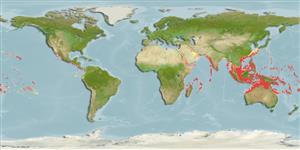>
Acanthuriformes (Surgeonfishes) >
Chaetodontidae (Butterflyfishes)
Etymology: Heniochus: Greek, enioi, -ai, -a = sometimes, some + Greek, oche = food (Ref. 45335).
More on authors: Smith & Radcliffe.
Environment: milieu / climate zone / depth range / distribution range
Ecologia
marinhas associadas(os) a recifes; intervalo de profundidade 2 - 250 m (Ref. 90102), usually 15 - 40 m (Ref. 9710). Tropical; 32°N - 23°S
Pacific Ocean: Andaman Islands in the eastern Indian Ocean to Samoa, north to southern Japan, south to Rowley Shoals and New Caledonia.
Tamanho / Peso / Idade
Maturity: Lm ? range ? - ? cm
Max length : 30.0 cm TL macho/indeterminado; (Ref. 48636)
Espinhos dorsais (total) : 11 - 12; Raios dorsais moles (total) : 25 - 27; Espinhos anais: 3; Raios anais moles: 17 - 18.
An uncommon species (Ref. 9710) that inhabits deep lagoon and seaward reefs. Adults solitary or in small groups and prefer areas with rich coral growth and high vertical relief (Ref. 1602). Juveniles solitary and secretive on inshore reefs. Largest of the bannerfishes (Ref. 48636). Feed on coral polyps (Ref. 9710). Oviparous (Ref. 205). Form pairs during breeding (Ref. 205).
Life cycle and mating behavior
Maturidade | Reprodução | Desova | Ovos | Fecundidade | Larvas
Form pairs during breeding (Ref. 205).
Randall, J.E., G.R. Allen and R.C. Steene, 1990. Fishes of the Great Barrier Reef and Coral Sea. University of Hawaii Press, Honolulu, Hawaii. 506 p. (Ref. 2334)
Categoria na Lista Vermelha da IUCN (Ref. 130435: Version 2024-2)
Ameaça para o homem
Harmless
Utilização humana
Pescarias: pouco comercial; Aquário: Espécies comerciais
Ferramentas
Relatórios especiais
Descarregue XML
Fontes da internet
Estimates based on models
Preferred temperature (Ref.
123201): 25 - 29, mean 28.1 °C (based on 840 cells).
Phylogenetic diversity index (Ref.
82804): PD
50 = 0.5039 [Uniqueness, from 0.5 = low to 2.0 = high].
Bayesian length-weight: a=0.01995 (0.00906 - 0.04395), b=3.01 (2.83 - 3.19), in cm total length, based on all LWR estimates for this body shape (Ref.
93245).
Nível Trófico (Ref.
69278): 3.6 ±0.44 se; based on food items.
Resiliência (Ref.
120179): Elevada, tempo mínimo de duplicação da população menor que 15 meses (Preliminary K or Fecundity.).
Fishing Vulnerability (Ref.
59153): Low vulnerability (20 of 100).
Nutrients (Ref.
124155): Calcium = 56.1 [28.3, 91.8] mg/100g; Iron = 0.628 [0.373, 1.013] mg/100g; Protein = 18.7 [17.6, 19.9] %; Omega3 = 0.138 [0.083, 0.228] g/100g; Selenium = 48.2 [26.8, 87.9] μg/100g; VitaminA = 45.8 [13.1, 156.3] μg/100g; Zinc = 0.996 [0.682, 1.426] mg/100g (wet weight);
